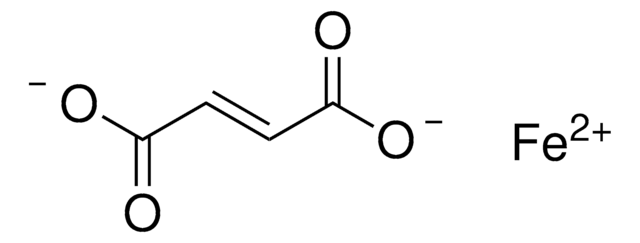A0207
(+)-Iron(II) L-ascorbate
≥90% (titration)
Synonym(s):
L-(+)-Ascorbic acid iron(II) salt, Ferrous ascorbate, Vitamin C iron(II) salt
Sign Into View Organizational & Contract Pricing
All Photos(1)
About This Item
Empirical Formula (Hill Notation):
C12H14FeO12
CAS Number:
Molecular Weight:
406.08
EC Number:
MDL number:
UNSPSC Code:
12352200
PubChem Substance ID:
NACRES:
NA.79
Recommended Products
Assay
≥90% (titration)
form
crystalline
color
dark brown
SMILES string
[H][C@@]1(OC(=O)C(O)=C1O[Fe]OC2=C(O)C(=O)O[C@]2([H])[C@@H](O)CO)[C@@H](O)CO
InChI
1S/2C6H8O6.Fe/c2*7-1-2(8)5-3(9)4(10)6(11)12-5;/h2*2,5,7-10H,1H2;/q;;+2/p-2/t2*2-,5+;/m00./s1
InChI key
RFBYLSCVRUTUSB-ZZMNMWMASA-L
Looking for similar products? Visit Product Comparison Guide
Biochem/physiol Actions
(+)-Iron(II) L-ascorbate or ferrous ascorbate has high potential to absorb iron in vivo compared to ferrous sulfate. In children, it is used as an effective oral iron supplement to treat iron deficiency anemia.
Iron-ascorbate (ferrous-ascorbate) is used as a reagent in cell culture and other systems to evaluate various aspects of oxidative stress and anti-oxidation mechanisms.
Caution
May darken in storage.
Storage Class Code
11 - Combustible Solids
WGK
WGK 3
Flash Point(F)
Not applicable
Flash Point(C)
Not applicable
Personal Protective Equipment
dust mask type N95 (US), Eyeshields, Gloves
Choose from one of the most recent versions:
Already Own This Product?
Find documentation for the products that you have recently purchased in the Document Library.
Customers Also Viewed
Hanne Vorwerk et al.
Molecular microbiology, 98(5), 809-830 (2015-08-12)
Thermophilic Campylobacter species colonize the intestine of agricultural and domestic animals commensally but cause severe gastroenteritis in humans. In contrast to other enteropathogenic bacteria, Campylobacter has been considered to be non-glycolytic, a metabolic property originally used for their taxonomic classification.
Bartosz Rózanowski et al.
Investigative ophthalmology & visual science, 49(7), 2838-2847 (2008-03-11)
To determine the effects of human retinal pigment epithelial (RPE) cell pigment granules on photosensitized and iron ion-mediated oxidation and the effect of the photodegradation of melanosomes on their antioxidant properties. RPE cells were isolated from human and bovine eyes;
Hanne Vorwerk et al.
Molecular microbiology, 93(6), 1224-1245 (2014-07-31)
The non-glycolytic food-borne pathogen Campylobacter jejuni successfully colonizes the intestine of various hosts in spite of its restricted metabolic properties. While several amino acids are known to be used by C. jejuni as energy sources, none of these have been
Rame Taha et al.
PloS one, 5(7), e11817-e11817 (2010-08-03)
Although mitochondrial dysfunction and oxidative stress are central mechanisms in various pathological conditions, they have not been extensively studied in the gastrointestinal tract, which is known to be constantly exposed to luminal oxidants from ingested foods. Key among these is
Ingrid Wiswedel et al.
Free radical research, 44(2), 135-145 (2010-01-22)
The aim of this study was to investigate the effect of oxidative stress on mitochondrial phospholipids. In this context, this study investigated (i) the content of phosphatidylethanolamine (PE), phosphatidylcholine (PC) and cardiolipin (CL), (ii) the correlation of CL degradation with
Our team of scientists has experience in all areas of research including Life Science, Material Science, Chemical Synthesis, Chromatography, Analytical and many others.
Contact Technical Service








